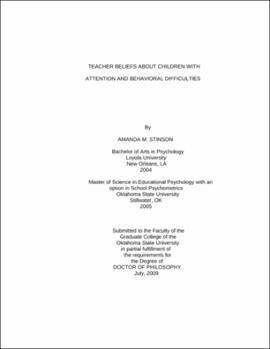| dc.contributor.advisor | Stinnett, Terry | |
| dc.contributor.author | Stinson, Amanda M. | |
| dc.date.accessioned | 2013-11-26T08:33:26Z | |
| dc.date.available | 2013-11-26T08:33:26Z | |
| dc.date.issued | 2009-07 | |
| dc.identifier.uri | https://hdl.handle.net/11244/7275 | |
| dc.description.abstract | Scope and Method of Study: The current study attempted to extend the current literature on the topic of teacher beliefs about students with attention and behavior difficulties. Teachers' attributions, prognostic outlook, and willingness to accept treatments for students with attention and behavior problems were studied using hypothetical scenarios about a child who was either labeled ADHD or not labeled ADHD. The child in the vignette was also either a 6 year old boy or an 11 year old boy who received either stimulant medication, behavioral intervention, or a combined treatment. Teacher's acceptability of the proposed treatment was measured using the Intervention Rating Profile - 15 (IRP-15) to assess whether treatment acceptability varied as a function of the label, age, and treatment conditions. Prognostic outlook for the child was also assessed to measure teacher beliefs about the child's likelihood for future success or failure, likelihood for further classroom disruption, and likelihood for success or failure in interpersonal relationships. Teachers were also asked to rate their attributions of the child's behavior. Items were designed to reflect each of the three causal attributions, locus, stability, and controllability, and teachers were asked to make their attributions of the child in the vignette along the three dimensions. | |
| dc.description.abstract | Findings and Conclusions: Teacher attributions of the child in the vignette did not differ based on label, age, and treatment. Overall, teachers attributed the cause of the child's behavior to internal, stable, and uncontrollable factors regardless of the label, age, and treatment condition. Teachers rated interventions as more acceptable when the child was labeled ADHD, with the work completion intervention rated as more acceptable for the 6 year old condition and stimulant medication rated higher for the 11 year old condition. Prognostic outlook ratings were highest when the child received the combined treatment package and lowest when the child was given the work completion intervention. | |
| dc.format | application/pdf | |
| dc.language | en_US | |
| dc.rights | Copyright is held by the author who has granted the Oklahoma State University Library the non-exclusive right to share this material in its institutional repository. Contact Digital Library Services at lib-dls@okstate.edu or 405-744-9161 for the permission policy on the use, reproduction or distribution of this material. | |
| dc.title | Teacher beliefs about children with attention and behavioral difficulties | |
| dc.contributor.committeeMember | Duhon, Gary | |
| dc.contributor.committeeMember | Yetter, Georgette | |
| dc.contributor.committeeMember | Fuqua, Dale | |
| osu.filename | Stinson_okstate_0664D_10277.pdf | |
| osu.accesstype | Open Access | |
| dc.type.genre | Dissertation | |
| dc.type.material | Text | |
| thesis.degree.discipline | Educational Psychology | |
| thesis.degree.grantor | Oklahoma State University | |
